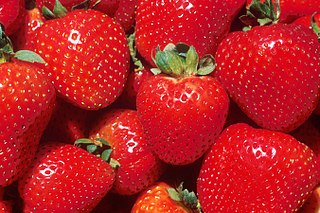
Red is the color at the long wavelength end of the visible spectrum of light, next to orange and opposite violet. It has a dominant wavelength of approximately 625–740 nanometres. It is a primary color in the RGB color model and a secondary color in the CMYK color model, and is the complementary color of cyan. Reds range from the brilliant yellow-tinged scarlet and vermillion to bluish-red crimson, and vary in shade from the pale red pink to the dark red burgundy.

A quilt is a multi-layered textile, traditionally composed of two or more layers of fabric or fiber. Commonly three layers are used with a filler material. These layers traditionally include a woven cloth top, a layer of batting or wadding, and a woven back combined using the techniques of quilting. This is the process of sewing on the face of the fabric, and not just the edges, to combine the three layers together to reinforce the material. Stitching patterns can be a decorative element. A single piece of fabric can be used for the top of a quilt, but in many cases the top is created from smaller fabric pieces joined, or patchwork. The pattern and color of these pieces creates the design. Quilts may contain valuable historical information about their creators, "visualizing particular segments of history in tangible, textured ways".

A baseball cap is a type of soft hat with a rounded crown and a stiff bill projecting in front.

A livery is an identifying design, such as a uniform, ornament, symbol or insignia that designates ownership or affiliation, often found on an individual or vehicle. Livery often includes elements of the heraldry relating to the individual or corporate body featured in the livery. Alternatively, some kind of a personal emblem or badge, or a distinctive colour, is featured.
Fascist symbolism is the use of certain images and symbols which are designed to represent aspects of fascism. These include national symbols of historical importance, goals, and political policies. The best-known are the fasces, which was the original symbol of fascism, and the swastika of Nazism.

A peaked cap, peaked hat, service cap, barracks cover, or combination cap is a form of headgear worn by the armed forces of many nations, as well as many uniformed civilian organisations such as law enforcement agencies and fire departments. It derives its name from its short visor, or peak, which was historically made of polished leather but increasingly is made of a cheaper synthetic substitute.
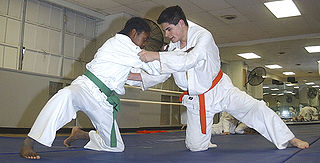
Judogi, also called keikogi or dogi, is the formal Japanese name for the traditional uniform used for Judo practice and competition.

The Boy Scouts of America (BSA) use uniforms and insignia to give a Scout visibility and create a level of identity within both the unit and the community. The uniform is used to promote equality while showing individual achievement. While all uniforms are similar in basic design, they do vary in color and detail to identify the different membership divisions of Cub Scouting, Scouts BSA and Venturing. Many people collect BSA insignia such as camporee and jamboree emblems, council shoulder strips and historical badges.

Shoulder sleeve insignia (SSI) are distinctive cloth patches worn on the left sleeve of the United States Army uniform just below the shoulder seam by soldiers assigned to divisions, corps, armies, and other specifically authorized organizations. They are also worn on the right sleeve by soldiers to indicate former overseas service with certain units during periods of U.S. military operations in hostile conditions (MOHC).
Star Trek uniforms are costumes worn by actors portraying personnel of a fictitious Starfleet in various television series and films in the Star Trek science fiction franchise. During the various series, the costume design has often changed to represent different time periods and for reasons of appearance and comfort. Sometimes different styles were deliberately mixed to enhance the sense of time travel or alternative universes.
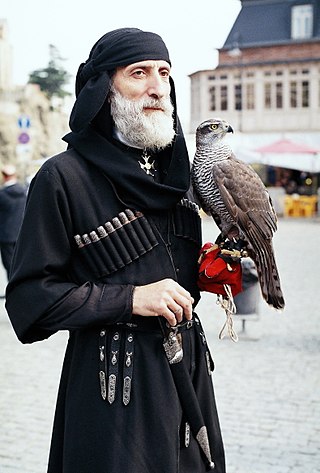
A chokha, also known as a cherkeska, is a woolen coat with a high neck that is part of the traditional male dress of peoples of the Caucasus. It was in wide use among Avars, Abazins, Abkhazians, Azerbaijanis, Balkars, Chechens, Circassians,Georgians, Ingush, Karachays, Kumyks, Nogais, Ossetians, Tats, the peoples of Dagestan, as well as Terek, Kuban Cossacks, Eastern Armenians Kurdsfrom Russian empire who adopted it from the aforementioned peoples.

Gorget patches are an insignia in the form of paired patches of cloth or metal on the collar of a uniform (gorget), used in the military and civil service in some countries. Collar tabs sign the military rank, the rank of civil service, the military unit, the office (department) or the branch of the armed forces and the arm of service.

Type 07 is a group of military uniforms used by all branches of the People's Liberation Army (PLA) of the People's Republic of China (PRC) and the paramilitary Chinese People's Armed Police Force. Introduced in 2007, the Type 07 uniforms replaced the Type 87 service uniforms used by regular units and the Type 97 Service Dress uniforms of the People's Liberation Army Hong Kong Garrison and the People's Liberation Army Macau Garrison. The Type 07 uniforms were first seen in late June 2007 during a celebration ceremony for the 10th anniversary of the Transfer of sovereignty over Hong Kong.

An embroidered patch, also known as a cloth badge, is a piece of embroidery which is created by using a fabric backing and thread. The art of making embroidered patches is an old tradition and was done by hand. During the first half of the twentieth century they were commonly embroidered using a shiffli embroidery machine. High-speed, computerized machines have led to mass production.
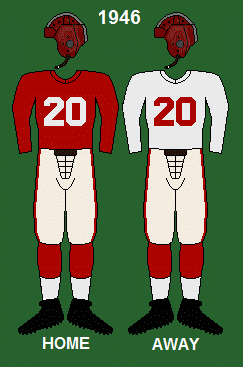
The logo and uniforms of the San Francisco 49ers have evolved since their inception in 1946.

Troops began wearing berets as a part of the headgear of military uniforms in some European countries during the 19th century; since the mid-20th century, they have become a component of the uniforms of many armed forces throughout the world. Military berets are usually pushed to the right to free the shoulder that bears the rifle on most soldiers, but the armies of some countries, mostly within Europe, South America, and Asia, have influenced the push to the left.
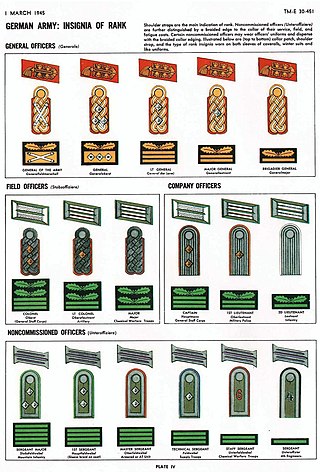
The Heer as the German army and part of the Wehrmacht inherited its uniforms and rank structure from the Reichsheer of the Weimar Republic (1921–1935). There were few alterations and adjustments made as the army grew from a limited peacetime defense force of 100,000 men to a war-fighting force of several million men.

The New York Mets, founded in 1962, returned National League baseball to New York following the departure of the Brooklyn Dodgers to Los Angeles and the New York Giants to San Francisco. The Mets' uniform was designed to incorporate elements of both departed clubs, with the Dodgers' royal blue becoming the Mets' primary color and the Giants' orange the trim color, along with the Giants' "NY" crest adopted as the new team's cap logo. The original Mets uniform had a "clean and classic" look that, while it has undergone a number of changes over the course of the team's history, has never been substantially revised. The basic template has always been a conventional short-sleeved baseball uniform with "Mets" in cursive script on a white pinstriped home jersey, and either "NEW YORK" or "Mets" on a gray road jersey, with the lettering and numerals in blue outlined in orange. The most notable variations were the "racing stripe" uniforms of the 1980s and early '90s, and the addition of black as a trim color along with black alternate jerseys and caps that were worn from 1998 through 2011. For 2012, in recognition of its 50th anniversary, the club restored its classic look by removing the black trim from all of its uniforms and phasing out the black jerseys and caps. Since then the club has adopted blue alternate jerseys and caps but has generally worn its primary uniform in most games, home and away.

A suit jacket, also called a lounge jacket, dress jacket, lounge coat or suit coat, is a jacket in classic menswear that is part of a suit.

E.M.R. ; or Universal Camouflage Colourway in English, is a military camouflage pattern in use by the Russian Armed Forces. It is sometimes referred to by the unofficial nicknames RUSPAT, Tetris, Tsifra and Digital Flora. EMR camouflage is the standard camouflage pattern of the Russian Military's V.K.B.O. All-Season Uniform.




















